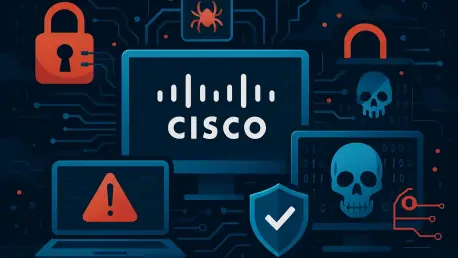In a world increasingly reliant on digital infrastructure, a staggering cybersecurity flaw has left thousands of Cisco IOS XE devices exposed to malicious actors, with over 15,000 systems worldwide still bearing the scars of the BadCandy implant. This sinister tool exploits a vulnerability so severe that it scores a perfect 10 on the severity scale, known as CVE-2023-20198, continuing to haunt organizations, governments, and critical sectors. This raises an urgent question: why does this threat linger despite global awareness and mitigation efforts?
The significance of this crisis cannot be overstated. Since its discovery as a zero-day exploit, CVE-2023-20198 has compromised over 42,000 devices, with ongoing waves of attacks targeting the web interface of Cisco IOS XE software. The stakes are high, affecting not just individual businesses but also national security and public safety. This pervasive threat, driven by sophisticated actors, demands immediate attention and robust action from all stakeholders relying on Cisco’s widely used networking solutions.
Why Hackers Keep Targeting Cisco Systems
The allure of Cisco IOS XE devices for cybercriminals lies in their widespread use across critical infrastructure and enterprise networks. These systems form the backbone of countless organizations, making them high-value targets for exploitation. The CVE-2023-20198 flaw provides an ideal entry point, allowing attackers to deploy the BadCandy implant with devastating consequences, from data theft to network control.
What fuels this relentless pursuit is the vulnerability’s severity and the slow pace of patching in many environments. Despite Cisco releasing updates, numerous devices remain unpatched due to operational constraints or lack of awareness. Hackers exploit this gap, continuously scanning for vulnerable systems to install backdoors, ensuring their foothold in compromised networks for extended periods.
The global scope of affected systems adds another layer of complexity. From government agencies to private corporations, the diversity of targets means that a single breach can cascade into broader systemic risks. This persistent targeting underscores the need for heightened vigilance and faster response mechanisms to counter an evolving threat landscape.
A Global Cybersecurity Crisis Unfolds
The impact of this vulnerability transcends borders, creating a cybersecurity crisis of unprecedented scale. According to the Shadowserver Foundation, over 15,000 devices still show signs of BadCandy implants, a chilling reminder of the flaw’s enduring reach. Initially, over 42,000 systems were hit, illustrating how quickly the exploit spread across the globe.
Government bodies have sounded the alarm on the real-world consequences. In Australia, the Signals Directorate reported over 400 potentially compromised devices since mid-2025, with more than 150 still affected as of recent updates. Meanwhile, in the United States, the Cybersecurity and Infrastructure Security Agency (CISA) has flagged the issue in its Known Exploited Vulnerabilities catalog, urging immediate action to protect critical infrastructure.
The stakes are particularly high for sectors like telecommunications and public utilities, where a breach could disrupt essential services. Reports of coordinated attacks on major U.S. telecom providers highlight the potential for widespread societal impact. This crisis serves as a stark warning that no organization is immune, pushing cybersecurity to the forefront of strategic priorities.
Decoding the BadCandy Implant’s Complex Threat
Understanding the BadCandy threat requires dissecting its technical underpinnings and attack patterns. At its core, the CVE-2023-20198 flaw in Cisco IOS XE’s web interface allows unauthorized access, enabling attackers to install the implant as a persistent backdoor. This mechanism has been exploited in multiple waves since its discovery, demonstrating the adaptability of malicious actors.
The numbers paint a grim picture of the threat’s scope. Australian authorities alone have identified hundreds of affected devices, a microcosm of the global challenge. Beyond raw data, the involvement of sophisticated actors adds intrigue—researchers suspect state-sponsored groups like the China-linked Salt Typhoon, though definitive evidence remains elusive, as noted by GreyNoise in their analysis of attack patterns.
Distinguishing between mere scanning and actual exploitation poses an ongoing challenge for defenders. Many observed activities may represent opportunistic probes rather than confirmed breaches, complicating response efforts. This nuanced reality highlights the importance of continuous monitoring and advanced threat detection to stay ahead of stealthy adversaries exploiting this flaw.
Expert Voices Weigh in with Caution
Navigating the murky waters of cybersecurity attribution demands a careful approach, as experts refrain from hasty conclusions. GreyNoise researchers have observed that recent exploit attempts align with patterns seen over the past few months but have not confirmed new BadCandy deployments. This measured stance reflects the difficulty in separating routine scans from active threats.
Other voices in the field echo similar caution. Rapid7 has pointed to potential links with China-connected actors in what they term “CN Clustered activities,” yet they stop short of firm attribution. CISA, while maintaining the vulnerability in its critical catalog, offers no fresh insights on BadCandy activity, suggesting a stabilization in attack trends but not an end to the risk.
These expert perspectives underscore a broader challenge in cybersecurity: the blurred lines between state-sponsored operations and criminal enterprises. Without concrete evidence of post-exploitation actions, assigning responsibility remains speculative. This uncertainty reinforces the need for organizations to focus on defense rather than dwelling on the identity of their adversaries.
Practical Defenses Against an Enduring Vulnerability
Mitigating the BadCandy threat starts with actionable steps tailored to Cisco IOS XE environments. Australian authorities have advised that rebooting infected devices can remove the implant, but this is only a temporary fix. Attackers who have stolen credentials or established alternate access points can regain control, necessitating deeper security measures.
Beyond reboots, applying Cisco’s latest patches is non-negotiable. Organizations must prioritize updating their systems to close the CVE-2023-20198 loophole, alongside implementing strict access controls to limit unauthorized entry. Regular monitoring for unusual network activity can also help detect lingering threats before they escalate into full-blown breaches.
A comprehensive strategy involves fostering a culture of cybersecurity awareness within organizations. Training staff to recognize potential risks and ensuring rapid response protocols are in place can make a significant difference. By combining technical solutions with proactive policies, entities can build a resilient defense against a vulnerability that shows no sign of fading away.
Reflecting on a Battle Fought and Lessons Learned
Looking back, the struggle against the BadCandy implant revealed the fragility of even the most trusted digital systems. Thousands of Cisco IOS XE devices bore the brunt of a flaw that cybercriminals exploited with ruthless precision, affecting global networks in profound ways. The coordinated efforts of governments and researchers shed light on the scale of the challenge, even as attribution remained elusive.
Moving forward, the emphasis shifted toward stronger safeguards and faster patch deployment. Organizations learned that temporary fixes like reboots were insufficient against determined adversaries who adapted their tactics. The path ahead demanded investment in advanced monitoring tools and international collaboration to preempt future waves of similar exploits.
Ultimately, the saga of this vulnerability underscored a timeless truth: cybersecurity is an ongoing journey, not a destination. Stakeholders were urged to remain proactive, sharing intelligence and refining defenses to protect against evolving threats. By embracing these lessons, the global community aimed to turn a crisis into a catalyst for lasting resilience.









